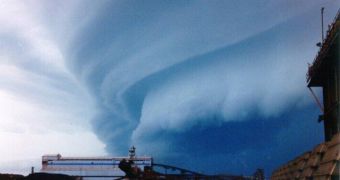Well, the global warming seems to have brought us enough bad news in the past decades, so scientists think it's finally time to release some good news. Contrary to the common belief that global warming would result in an increase in hurricane rates, a computer model simulated by the US National Oceanic and Atmospheric Administration's Geophysical Fluid Dynamics Laboratory shows that in fact the number of hurricanes in the North Atlantic is dropping.
Since the 1950s, the number of hurricanes has been steadily increasing, not to mention that since the 1980 they seemed to have experienced an increase in power. Most of the studies conducted in this field show that this increase can be blamed on the rise in sea-surface temperatures, since heat is what powers hurricanes the most. The problem is that this phenomenon seems to happen only in the Atlantic region, since other ocean basins did not experience any significant increase in hurricane number.
Hurricane rates decrease
Just as in real life, the model created spontaneous hurricanes and tropical storms. Additionally, the model predicted that in the last 25 years at least 162 storms should have appeared, while only 143 were ever recorded. Then, Tom Knutson and his colleagues from the US National Oceanic and Atmospheric Administration's Geophysical Fluid Dynamics Laboratory ran a model predicting how Atlantic water temperatures would rise accordingly to the climate change.
The climate model first simulated a scenario in which carbon dioxide emissions increase towards the middle of the century, then a scenario predicting the future carbon-dioxide concentrations. The results show that even though carbon emissions would drop, the waters would continue to warm up beyond the end of this century. The model then showed that hurricane rates should decrease by the end of the century, more precisely, we'll have 27 percent less tropical storms and 18 percent less hurricanes in the Atlantic area.
"This study does not support the idea there is a large increasing trend in hurricanes due to greenhouse warming", says Knutson.
However, hurricane power will suffer a slight increase. "We don't want to take it quantitatively too seriously because it's not simulating stronger storms very well. It gives more support to the idea that in the tropics in general, hurricanes will be slightly more intense and have more rainfall", said Knutson.
Flawed model?
Critics, on the other hand, claim that the model must be somehow flawed, since it did not produce hurricanes of category four or five in the 20th century, nor in the 21st. "In this study there is a suggestion that the strongest storms increase, but the model never simulates them in the first place. It could be grossly in error for the strongest storms, which are the ones that do most damage", said Kevin Trenberth, National Center for Atmospheric Research scientist.
"My only reservation is that the model's spatial resolution is still too low to allow for intense hurricanes", says Kerry Emanuel from the Massachusetts Institute of Technology, who carried out similar studies, showing an increase in hurricane intensity in the northern hemisphere.

 14 DAY TRIAL //
14 DAY TRIAL //